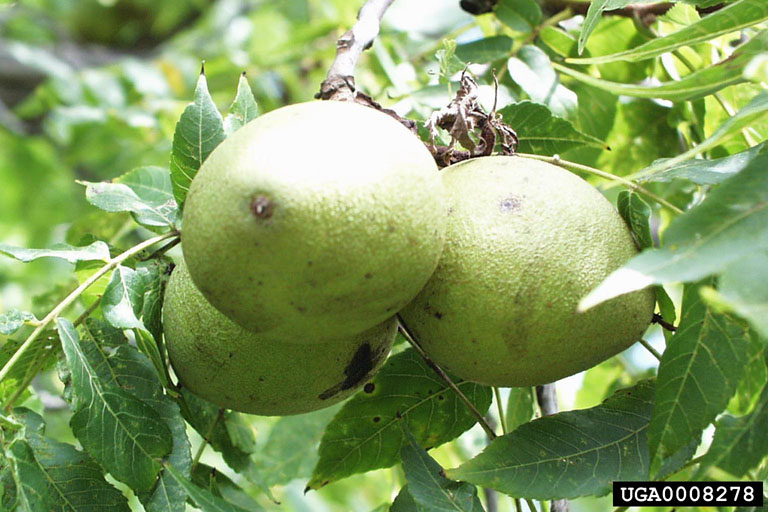The holidays will soon be upon us. This season of the year is when we often do a lot of baking. It is fun, you are stuck inside anyway, and baked goods are great gifts for your friends and neighbors. Nuts are a great addition to many baked goods, especially Black Walnuts, and these can be grown right in your own backyard.
Black walnut, Juglans nigra, is a native tree that grows up to 50-75 feet tall and a similar sized spread. Black walnut leaves are compound, alternately arranged, and 12-24 inches long with 15-23 leaflets. Each leaflet is 2-5 inches long, oblong shaped, and serrate on the edges. The leaves are dark green during the growing season but provide a yellow fall color. The flowers on black walnut are not showy. The fruit is a light green, round, nut. The husk of the nut will come off fairly easily when mature but the shell is difficult to crack to get to the meat of the nut inside.
Black walnuts can be harvested when mature by shaking the tree or knocking them off with a long pole. Mature walnuts are softened on the outside. When harvesting or preparing nuts for eating, it is best to wear gloves because the nuts produce a black substance that will stain just about anything. Once the mature walnuts are harvested, the husks need to be removed, which can be done by rolling the nut on a hard surface with a heavy foot or driving over it with a car. This will pull the hull off but leave the nut intact. Once the nut is out of the husk, rinse the nuts in a bucket of water. If the nut floats, that is an empty shell with no meat in it. Next dry the nuts in a location with good airflow for 4-5 weeks until cracking open. Cracking the shells is difficult but can be done with a hammer or a squeeze in a vise. Store nuts out of the shell in the freezer for long-term storage or they will be no good. Black walnuts can be used in place of English walnuts in your recipes. This information on harvesting black walnuts came from Michigan State University Extension.
Juglone is a chemical produced by members of the Juglandaceae family of plants which includes black walnut, butternut, and hickories. This chemical is produced in the buds, leaves, stems, nut hulls, and roots of these plants and can inhibit and sometimes restrict the growth and even kill other plants growing near black walnuts. This is a natural way for the tree to reduce competition from nearby plants. Juglone can even be found in mulch made from these parts of the tree. The best defense against Juglone is to plant at least 50 yards from the tree or use a raised bed if space is limited. Tomatoes, potatoes, peppers, and eggplants are all susceptible to juglone but corn, beans, onions, beets, and carrots are tolerant. When planting near a black walnut, it is best to use plants that are tolerant of Juglone to avoid the problems associated with it.
One thing to be on the lookout for with black walnut trees is the susceptibility to Thousand Cankers Disease. This is a disease that has not been found in Nebraska yet, but can cause death to black walnut trees. Thousand Cankers disease is caused by a fungus that is spread by a tiny black beetle the feeds under the bark. This disease causes yellowing foliage followed by brown, wilted foliage and branch dieback and eventual death of the tree. The disease can kill the tree in 2-3 years. There is no control for the disease, but there is a quarantine restricting the movement of walnut wood into Nebraska from other states. The quarantine is meant to slow the spread of the disease and save the black walnut trees in our state.
Black walnut wood is a high-value wood that is used for many different wood furniture pieces among other things. According to Minnesota Extension, Black walnut wood is used for veneer for wall panels, doors, furniture, and cabinets. The nuts are used in baking, ice cream, and as a food source for squirrels, deer, and birds. The shells can be ground to use as a polishing abrasive and have been used in the past as a dye.
Black walnut is a great tree that will grow in most locations, including wet soils. It doesn’t tolerate shade locations very well, but will still grow there, just much slower. There are a lot of great products you can gain from planting black walnut trees, just ensure that the tree is planted farther away from your vegetable garden, small fruit plots, and some other trees and shrubs to avoid the problems with Juglone. So, the next time you are looking for a new shade tree with potential for nut harvest, look at Black Walnut.

